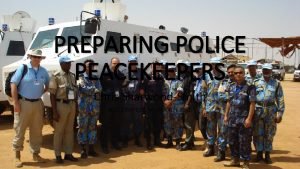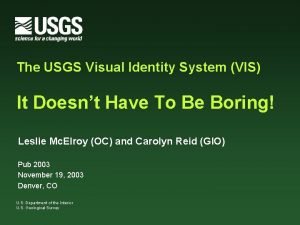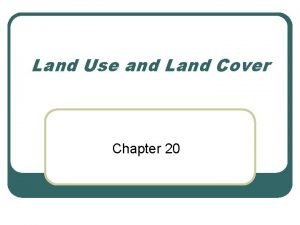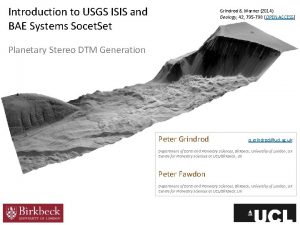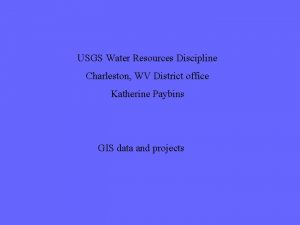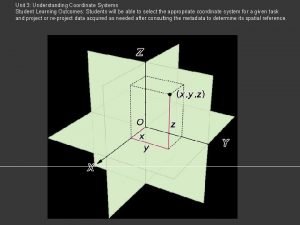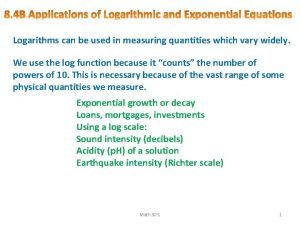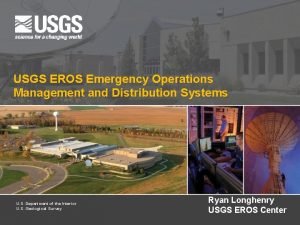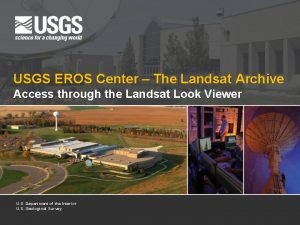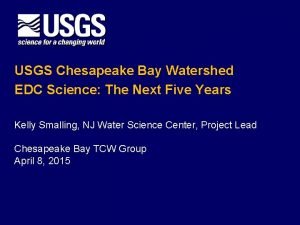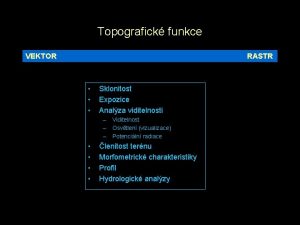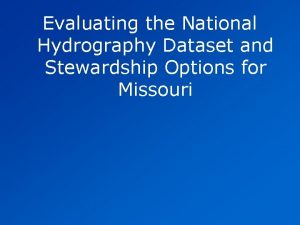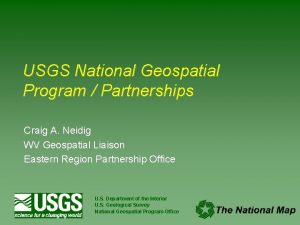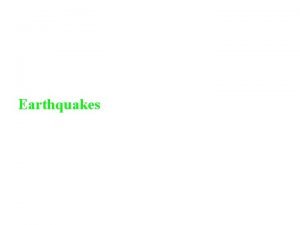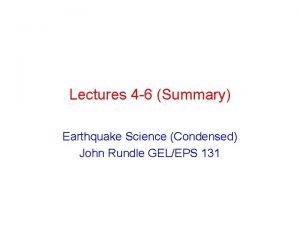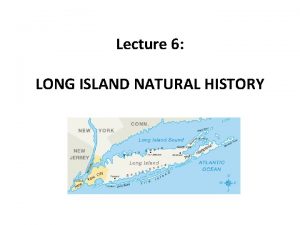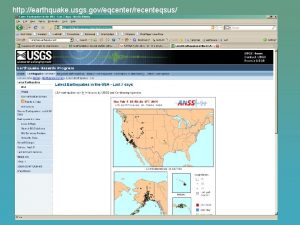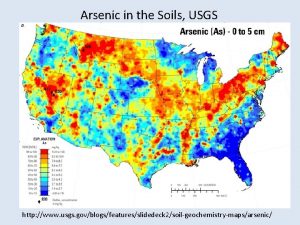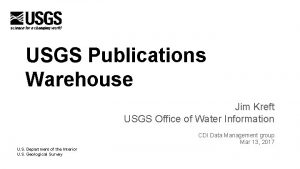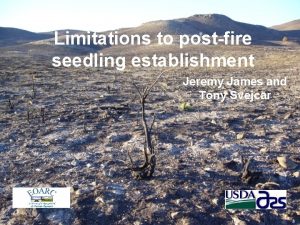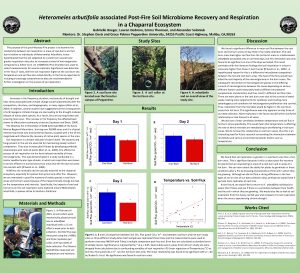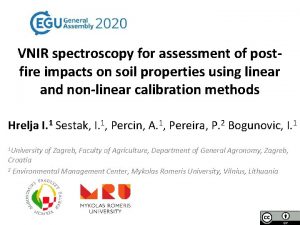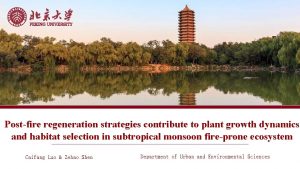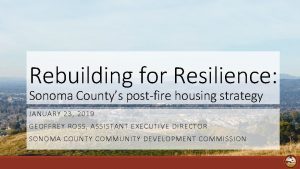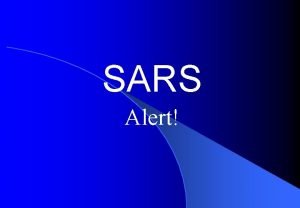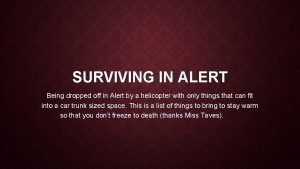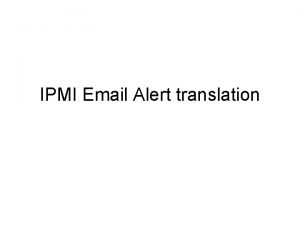POSTFIRE USGS and ALERT SYSTEMS Chris Smith USGS


















- Slides: 18

POST-FIRE USGS and ALERT SYSTEMS Chris Smith, USGS Brian Cosson, ADWR Michael Schaffner, NWS 2012 Southwest Wildfire Hydrology and Hazards Workshop Biosphere 2 April 2 -5, 2012

q 2 The USGS has over 7, 292 gauging station throughout the Nation, 4, 200 of which are equipped with satellite telemetry that provide real-time communications. The NWS uses data from 3, 971 of these stations to forecast river depth and flow conditions.

q q 3 Data are delivered automatically to National Weather Service (NWS), it is routed to NWS river forecast centers, and their local offices at 5 minute time intervals during extreme events. Data is also delivered to the USGS system where it is made available to the general public on the USGS web site NWISWEB, and transferred to the Arizona Flood Warning System (AFWS).

Water. Alert 4 q An important feature of the gages is that they can be monitored by the general public through the USGS website, http: //waterdata. usgs. gov. Through this site, historic and real-time information on stream flow and precipitation can be viewed. Residents can also subscribe free of charge to the Water. Alert notification system. This system allows individuals to be notified via e-mail or cel phone text message when an alert occurs. q q “This is an exciting advancement in technology, ” said County Manager Delwin Wengert. “It provides our residents access to the same information as our emergency responders. Residents can also personalize the system so that the drainage areas they are most concerned about are reported, and the trigger values such as amount of rainfall and river height can be customized. ” “We think this is an important means of empowering our residents to plan for the inevitable flooding that will occur in the aftermath of Wallow. It’s not just the current monsoon season where vigilance is called for, but the spring runoff and the whole cycle that will repeat itself over the next few years as the forest heals. With scientists telling us that a typical 1 to 2 year rainfall could result in 50 - to 100 -year runoff, it’s important that residents have and use this technology as another tool to protect themselves. ”

Water. Alert 5

q AFWS is a collection of 50 repeaters, 16 base stations and over 2000 sensors. 6

AFWS Website 7 MARTA – Yosemite Cloud© q q q GIS Ø National Data Sets Ø Local Data Sets Meteorological Data Ø RADAR Ø Satellite Imagery Under Construction Agency Data Ø ALERT (local and state) Ø USGS General Flood Warning Information Project Management and Communication Forum

8 Role of the National Weather Service q q q Local weather forecast offices are open 24/7/365. Forecasters and hydrologists at those offices are evaluating conditions likely to produce excessive rainfall. NWS radar, USGS stream gages, and county/state ALERT gages are interrogated. Flash Flood Warnings (FFWs) are issued when rainfall exceeds thresholds over burn areas. FFWs alarm the Emergency

Eagar Area 9 New flood warning gage (satellite telemetered) New rain gage at existing gage (satellite telemetered) New rain gage (radio telemetered)

Water Canyon Flood Warning Gage 10

Water Canyon Flood Warning Gage Cont. 11 q Stream gages installed in burned areas need a variety of sensors to handle the extreme conditions of runoff from burned areas. Non-contact sensors, such as radar, can be used in concert with redundant sensors to ensure survivability of the gage. q The monitoring sites can be used both for hazard warning and for scientific data collection. q Rapid deployment of the gages is essential for the protection of threatened communities and also for the collection of data from the first storm event.

MONTEZUMA CANYON WASH AT CORONADO NATL MEMORIAL 12

MONTEZUMA CANYON WASH 13 q q q This site is a Flood Warning Station located in Montezuma Canyon and was installed 08/17/2011. It measures precipitation and storm runoff in the burned area of the Monument Fire. The station consist of two rain-gages, one water level sensor, and a Data Collection Platform (DCP). Data from these sensors are stored and transmitted via satellite telemetry and are displayed on the web. Two additional stage sensors record stage data in the continuous slope-area reach. One rain-gage is located near the visitors' center and the other is located at the Montezuma Pass Lookout. The station can be configured into a data-collection cluster that allows a satellite-telemetered master gage to collect data from up to 12 remote gages (sensors). The remote gages can be used to collect many types of data including precipitation, river stage, and soil moisture. The remote gages are limited to a range of 5 miles, and must have line of site with the master gage.

14 MONTEZUMA CANYON WASH GAGE

Precipitation Gages 15 Ash Canyon ALERT Gauge, Cochise Co.

Coordination Challenges for Installing Systems 16 q q q Staff Availability for Multiple Meetings Limited Local Knowledge of Flood Warning Systems Access to Critical Locations Lack of Local Experience with Selecting Site Locations Identifying Type of Data Needed, and Who Needs it Identifying Resources Early in the Process

_ Funding Issues _ 17 _ _ q Limited Agency Resources _ q Funding Comes too Late to Measure First _ Event q Limited Funding Possibilities q No Clear Funding Source _ q Disaster Declarations _ _ q

Contact Information 18 Chris Smith (cfsmith@usgs. gov) Assistant Director Arizona Water Science Center Phone: (520) 670 -6671 520 North Park Ave. , Suite 221 Tucson, AZ 85719 Brian Cosson (btcosson@azwater. gov) Engineering and Permits Division Flood Warning Unit 3550 N. Central Ave. , 2 nd Floor Phoenix, AZ 85012 Office Phone: (602) 771 -8657 Cell: (602) 679 -0937 Michael Schaffner (mike. schaffner@noaa. gov) NOAA/National Weather Service Western Region Headquarters 125 South State Street Salt Lake City, Utah 84103 Phone: (801) 524 -5121 Miller Canyon, Cochise County July 2011
 Chris sharwood-smith
Chris sharwood-smith Usgs core research center
Usgs core research center Vis visual identity system
Vis visual identity system Usgs land use classification
Usgs land use classification Usgs isis
Usgs isis Usgs streamflow wv
Usgs streamflow wv Usgs sentinel 2
Usgs sentinel 2 Usgs map projections poster
Usgs map projections poster Http://earthquake.usgs.gov/earthquakes/map/
Http://earthquake.usgs.gov/earthquakes/map/ Usgs nawqa
Usgs nawqa Http://earthexplorer.usgs.gov/
Http://earthexplorer.usgs.gov/ Http://earthexplorer.usgs.gov/
Http://earthexplorer.usgs.gov/ Usgs chesapeake bay
Usgs chesapeake bay Webgis adalah
Webgis adalah Usgs national hydrography dataset
Usgs national hydrography dataset Usgs
Usgs Usgs
Usgs Usgs.gov
Usgs.gov Long island terminal moraine
Long island terminal moraine
